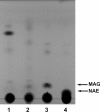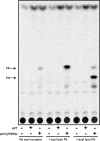Putative N-acylphosphatidylethanolamine synthase from Arabidopsis thaliana is a lysoglycerophospholipid acyltransferase
- PMID: 21803774
- PMCID: PMC3190788
- DOI: 10.1074/jbc.M111.269779
Putative N-acylphosphatidylethanolamine synthase from Arabidopsis thaliana is a lysoglycerophospholipid acyltransferase
Abstract
AT1G78690, a gene found in Arabidopsis thaliana, has been reported to encode a N-acyltransferase that transfers an acyl chain from acyl-CoA to the headgroup of phosphatidylethanolamine (PE) to form N-acylphosphatidylethanolamine (N-acyl-PE). Our investigation suggests that At1g78690p is not a PE-dependent N-acyltransferase but is instead a lysoglycerophospholipid O-acyltransferase. We overexpressed AT1G78690 in Escherichia coli, extracted the cellular lipids, and identified the accumulating glycerophospholipid as acylphosphatidylglycerol (acyl-PG). Electrospray ionization quadrupole time-of-flight mass spectrometry (ESI-MS) analysis yielded [M - H](-) ions, corresponding by exact mass to acyl-PG rather than N-acyl-PE. Collision-induced dissociation mass spectrometry (MS/MS) yielded product ions consistent with acyl-PG. In addition, in vitro enzyme assays using both (32)P- and (14)C-radiolabeled substrates showed that AT1G78690 acylates 1-acyllysophosphatidylethanolamine (1-acyllyso-PE) and 1-acyllysophosphatidylglycerol (1-acyllyso-PG), but not PE or phosphatidylglycerol (PG), to form a diacylated product that co-migrates with PE and PG, respectively. We analyzed the diacylated product formed by AT1G78690 using a combination of base hydrolysis, phospholipase D treatment, ESI-MS, and MS/MS to show that AT1G78690 acylates the sn-2-position of 1-acyllyso-PE and 1-acyllyso-PG.
Figures









References
Publication types
MeSH terms
Substances
Grants and funding
LinkOut - more resources
Full Text Sources
Other Literature Sources
Molecular Biology Databases

